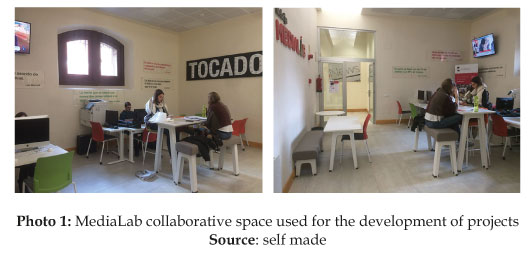
doi.org/10.15178/va.2018.142.39-49
RESEARCH
THE UNIVERSITY JOURNAL [N] AS A MULTIDISCIPLINARY PROJECT WITHIN THE SPACE NEBRIJA MEDIALAB
LA REVISTA UNIVERSITARIA [N] COMO PROYECTO MULTIDISCIPLINAR DENTRO DEL ESPACIO NEBRIJA MEDIALAB
A REVISTA UNIVERSITÁRIA (N) COMO PROJETO MULTIDISCIPLINAR DENTRO DO ESPAÇO NEBRIJA MEDIALAB
Carlos Jiménez-Narros1 Doctor from the Complutense University of Madrid. Bachelor of Journalism from the Faculty of Information Sciences (UCM). Accredited professor in ACAP. Research and Doctorate Coordinator (2016-). Coordinator of the Degree in Journalism (2009-2016). Since 1994 he has been a professor at the Antonio de Nebrija University and author of papers and communications in different international congresses on communication, graphic design and university education. He has published book chapters in publishing houses such as “Fragua”, “Mc Graw Hill” and “Dykinson”; and articles in journals such as Creatividad y Sociedad, Vivat Academia, Opción y Estudios del Mensaje Periodístico. His research area is focused on graphic design, new technologies and teaching innovation. https://orcid.org/0000-0001-8311-0261
1University Nebrija. Spain
ABSTRACT
The Faculty of Communication of Nebrija University has shown great consideration towards the realization of projects that bring students closer to the reality of their profession. Some previous efforts in support of this commitment have offered students foundational training in professional skills that are required in the world of communication. For more than fifteen years, the university has been running extra-curricular activities that are regarded as a benchmark in the sector, such as the Festival of Youth in Advertising, the AdN Short Film Festival and the Nipho Journalism Contest. The purpose of this article is to present how the design and creation of a university journal [N], born in the heart of the Laboratory of Educational Innovation, Nebrija MediaLab, can turn into a multidisciplinary project of several laboratories (current events, advertising and design). This activity is being developed during the 2016-2017 academic year after the latest changes were incorporated into this media platform, which was first conceived in our center three years ago. The objective is for students to strengthen their professional curriculum while obtaining the necessary skill to be able to perform in the profession with more agility.
KEYWORDS: University journal, multidisciplinary project, MediaLab, Nebrija, [N] , professional skill
RESUMEN
La Facultad de Comunicación de la Universidad Nebrija muestra una gran sensibilidad hacia la realización de proyectos que acerquen a los estudiantes la realidad profesional. Algunas experiencias previas avalan este compromiso de ofrecer a los estudiantes una formación adecuada a las competencias profesionales que les requerirán las profesiones relacionadas con el mundo de la comunicación. Desde hace más de quince años esta universidad plantea actividades extraacadémicas que son un referente en el sector, es el caso del Festival Jóvenes Tocados por la Publicidad, Festival de Cortos AdN y Concurso Periodístico Nipho. El propósito de este artículo es plantear cómo el diseño y creación de una revista universitaria [N], nacida en el seno del Laboratorio de Innovación Docente Nebrija MediaLab, puede convertirse en un proyecto multidisciplinar de varios laboratorios (actualidad, publicidad y diseño). Esta actividad se está desarrollando durante el curso académico 2016-2017, tras los últimos cambios incorporados a esta plataforma de medios que nació en nuestro centro hace tres años. El objetivo perseguido es que los alumnos fortalezcan su curriculum profesional a la vez que obtienen las competencias necesarias para poder desenvolverse de manera más ágil dentro de la profesión.
PALABRAS CLAVE: Revista universitaria, proyecto multidisciplinar, MediaLab, Nebrija, [N] , competencias profesionales
RESUME
A faculdade de comunicação da Universidade Nebrija mostra uma grande sensibilidade para a realização de projetos que acerquem aos estudantes a realidade profissional. Algumas experiências prévias avaliam este compromisso de oferecer aos estudantes uma formação adequada às habilidades professionais que lhes requereram as profissões relacionadas com o mundo da comunicação. Desde mais de quinze anos está universidade planteia atividades extra acadêmicas que são um referente no setor, é o caso do¨ Festival Jóvenes Tocados por la Publicidad, Festival de Cortos AdE e Concurso Periodístico Nipho¨. O propósito deste artigo é propor como o desenho e a criação de uma revista universitaria (N) nascida no laboratório de Inovação Docente Nebrija Medilab, pode converter-se em um projeto multidisciplinar de vários laboratórios (atualidade, publicidade e desenho). Esta atividade se desenvolve durante o curso acadêmico 2016/2017, depois das últimas mudanças incorporadas a esta plataforma de meios que nasceu em nosso centro há três anos. O objetivo perseguido é que os alunos fortaleçam seu curriculum profissional ao mesmo tempo que obtém as habilidades necessárias para poder desenvolver-se de maneira mais ágil dentro da profissão.
PALAVRAS CHAVE: Revista universitária, Projeto multidisciplinar, MediaLab, Nebrija (N) , Habilidades profissionais
Received: 19/09/2017
Accepted: 30/10/2017
Published: 15/03/2018
Correspondence: Carlos Jiménez-Narros. cjimenez@nebrija.es
How to cite the article
Jiménez Narros, C. (2018). The university journal [N] as multidisciplinary project within the space Nebrija MediaLab [La revista universitaria [N] como proyecto multidisciplinar dentro del espacio Nebrija MediaLab]
Vivat Academia. Revista de Comunicación, nº 142, 39-49
doi: http://doi.org/10.15178/va.2018.142.39-49
Recuperado de http://www.vivatacademia.net/index.php/vivat/article/view/1056
1. INTRODUCTION: MEDIA LABORATORIES
Laboratories as research units have always been linked to natural sciences, but from the twentieth century onwards, they extended to the field of social sciences. Media labs known as “labs” are not only a trend in schools in many countries, but some media have also incorporated them as new spaces for professional work, putting the focus on experimentation. The process of continuous change and adaptation to the digital context in which we are immersed has undoubtedly fostered the development of these structures, where new formulas and opportunities for the future are sought, putting emphasis especially on innovation.
In this sense, González Alba (2016, p. 50) points out that there are four ways to innovate, based; on the product (new formats and narratives), the production of contents, the search for new revenues and the new organization and structure. Ramón Salavarría and Charo Sádaba (2016) of the University of Navarra have thoroughly studied this type of laboratories that have emerged since 2010. The great reference media began, such as The New Times, Washington Post and the BBC and they were followed later by others. Salaverría (2015) also points out that the activity generated in these laboratories serves four categories in particular: development of digital applications, exploration of new narratives and data journalism, promotion of new business projects and startups, and schools of professional training and media literacy.
In the case of Spain, the Audiovisual Innovation Laboratory of RTVE (2011), the Journalism Innovation Laboratory of the Diario de Navarra (2013), El Confidencial and the Vocento Innovation and Training Laboratory (2014) stand out. Salaverria and Sádaba (2016, p. 152) clarify that “media companies have to find a way to deal corporatively with the study and implementation of novelties. In some cases it can be by establishing a department or appointing an internal team dedicated to these tasks; at other times, it may be through an alliance with a university or a research center.”
2. OBJECTIVES: MEDIALAB NEBRIJA AS A MEDIA PLATFORM AND A COOPERATIVE SPACE FOR THE LEARNING OF STUDENTS
At the university level, Nebrija MediaLab was conceived in 2013, but it began its journey in the 2014-2015 academic year, focusing on three areas (current events, radio and television). The students published pieces in Nebrija News portal (editorial and photography), collaborated with the journal Nuestra and mounted a journal called Nuestra Facultad, taking advantage of the model of Nuestra journal, a legendary publication of this center that in its early years was made by the students and has subsequently become a means of institutional communication. In audiovisual, students collaborated with the Department of Communication in the development of several video-news, created a music video recorded in a sequence term (lipdub) and made three television programs: A place called Nebrija, Nebrija Billboard and Nebrija Report. On the Radio, the students, under the direction of Professor Sara Infante, carried out various programs and put different radio genres into practice. This first year, MediaLab was directed by Professor Marta Saavedra, alma mater, along with our dean, Marta Perlado, of this space for teaching innovation. As Perlado and Saavedra (2016) point out, one of the main characteristics of the project is that students work in their own space (open workspace) and simulate a real professional environment in which they do not work alone, but collaborate directly with professionals and professors.

In the 2015-2016 academic year, a new Advertising Laboratory led by Professor Isabel de Río is incorporated into the existing workshops (current events, radio and audiovisual). Its tasks are focused on the realization of advertising actions, specially designed to reinforce outstanding extra-academic activities, within the University. One of the first actions was to deliver a portion of pizza, in paper format, as a complaint, to summon students to the presentation of MediaLab. At the end of the meeting, the students could taste some pizzas, thus completing the advertising action. Another action that stands out was the one organized for Christmas. The students gave the professors of the faculty and the main authorities of the university center some homemade pastas and a personalized Christmas ornament. The organization of a street marketing action for the Nipho Journalistic Contest stands out, where some of the MediaLab students disguised as press distributors handed out to all participating students a publication that had the name of the journalistic contest as its headline. The action was carried out in the first day of work of this extra-academic activity, getting to increase the expectation among the students. At that moment, the four laboratories were under the supervision of Professor Mar Ramos.
Nebrija MediaLab has started, again, the 2016-2017 academic year with the training courses organized by the heads of this media platform. Thus, Elena Gijón, director of news on Onda Cero Radio, and Eduardo Castillo, a radio journalist and a professor, have been responsible for the formation of the Radio Laboratory, the latter taking charge, in addition, of the formation of the Laboratory of News. Leticia Rodríguez, a communications consultant and also a professor, has directed the Advertising Laboratory and Carlos Jiménez, a designer and a professor, has taught at the Design Laboratory. In addition, we have had the support of the staff of the Communication Department of Nebrija who has collaborated in a photography seminar given by Zaida del Río, a photographer from the University, and a video seminar given by Marcos Bort and Elena Martínez, both from the Audiovisual Department, necessary training for the Television Laboratory.
The main objective of these training sessions has been to provide content and a first base to students who have voluntarily signed up to Nebrija MediaLab. Participation in this media platform is managed as a club where students obtain academic credits, since within their curriculum there is a subject called Development of Participatory and Solidarity Spirit. Students can add credits in the different clubs offered until they reach a total of six. With each of the clubs, two credits are obtained, which is the equivalent to fifty hours of work. The training provided by the different laboratories (current events, radio, design and advertising and television) is the starting point because many of the students who choose the Nebrija MediaLab Club are taking the first course and do not have previous knowledge in these areas. This aspect of lack of training, as most students are in their first year, is perhaps the main problem that may arise. To solve it, we have foreseen that, in each of the laboratories, there are some student-captains, second- and third-year students who have already passed through Nebrija MediaLab in previous years, and who have experience. These captains help the professor in the task of training and teaching skills and abilities that they have already learned. Lack of training, being students in the first cycle, is offset by the great interest they have shown in having the opportunity to carry out and assume, from their first days at the University, professional challenges related to their profession. Write an article, take a picture, prepare an interview, think of a name for a new publication, lay out the pages of a journal or make an advertisement for a specific product have been some of their goals.
This academic year, 2016-2017, the MediaLab Television Lab has the peculiarity that we work with real professional experiences. We collaborate with Non Stop People (MoviStar +) recording from our set several programs of El Debate, a space in which the students of the University express their opinion about current issues that concern them and always proposed by the television network. So far, we have recorded four programs in which different topics have been discussed, such as the influence of the internet on music, the sexual orientation of toys or the preference to share an apartment or live in a residence. This collaboration entails students assuming the recording and edition of a series of videos to experts and a survey at street level, on the subject dealt with in the program. The audiovisual information pieces, once the appropriate quality controls have been passed, are issued in the program. We also launched a survey from the University twitter and collected data on a very specific question, the results of which are shown in a graph; this material is also prepared by the students. The television network advances the topic that is discussed in each program and the day of the recording; presenter, director, content manager and makeup artist move to the set of our center. This way, students assume different roles during the recording of the program: speakers, cameras, stage managers, filmmakers, sound operators and production assistants, among others.
In the philosophy of MediaLab, the rotating character of the students is implicit and they are intended to pass through the different laboratories, assuming different roles and functions so that their training is as complete as possible.
3. METHODOLOGY: THE DESIGN LABORATORY, A NOVELTY IN NEBRIJA MEDIALAB
In the 2016-2017 academic year, Nebrija MediaLab has incorporated the Design Laboratory into its offer. Its main objective is the multidisciplinary project to devise, design and layout a new journal made entirely by students, under the supervision of the professors responsible for the different laboratories involved. This active methodology is based on Project Based Learning (PBL) and allows the student to be at the center of the process, stimulating and increasing their commitment to the project and problem solving (Martí, 2010). It not only challenges students, but also motivates professors (Ken Bain, 2009). In this integrating project, the MediaLab components have to carry out the informative contents, the advertising pieces and distribute and design the pages of the publication.
In the Design Laboratory and after the training sessions, we started reviewing journals and newspapers that have awakened our interest and that have been directed to the same target audience, university students. Once the situation of the sector is known, we began to work with naming, creating the name of a brand. The students presented some possible names for the future journal, and among all of us we saw the suitability of choosing one that would identify with the philosophy and character of our university. Among the proposals of the students, the following stand out: Tílde, InfoNebrija, Nebrija Contigo, [N], Néroes and CQC (Things to Tell About). A vote was taken among the students and three of them were finalists: [N], CQC and Néroes. The last idea refers to the advertising campaign of the university: “Heróes”, but incorporating the “N” as an element of rupture and in tune with the first letter of the name, Nebrija.
These three finalist names were subsequently developed graphically by the three work teams we created. Each of them was directed by a second-year student who acted as captain and who served as spokesperson for the team and led each of the graphic proposals at the header of the journal. The three finalist ideas and the development of the header design were defended by each of the teams. The headers that were best received and aroused more interest in the students were Néroes and [N], the latter being the most valued by far. Similarly, within the teaching team of the Faculty of Communication, we created an Internal Commission formed by professors from the area of creativity, graphic design and art direction to consider and evaluate the name and design of the header of the future journal.
The winning header has been [N], both for the simplicity of the name and for the graphic proposal presented by this group of students. The capital “N” represents the first letter of the name of our university, Nebrija. In addition this letter of the alphabet, in small capitals, is formed by three strokes, two of them straight and one in diagonal that unites them, bringing majesty and unique elegance. The “N” is embraced by two brackets adding plasticity to the composition of the logo. To this simple header, it was necessary to add a brief subtitle to contextualize the publication, “Nebrija MediaLab”.
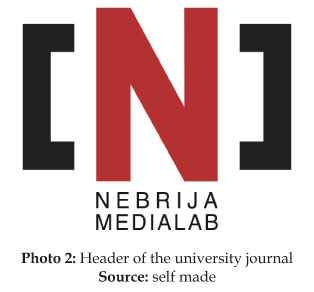
Once the design of the journal header has been decided, all section headers that appear on the inside pages have been worked in line with it, which in this first issue have been: “Opinion”, “Interview”, “Faculty “,” Reportage “,” Series-TV-Cinema “,” A step away from “Nebrija” and “Agenda”. All of them are bracketed, like the header but with a more casual typography, Creative. This same resource is also used in the footers facilitating the journey through the publication.
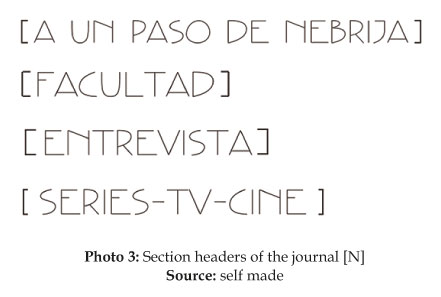
4. DISCUSSION: THE JOURNAL [N] AS AN INTEGRATING PROJECT
The creation of the journal [N] has managed to integrate, in a single professional project, the skills acquired in three of the five laboratories that exist in MediaLab (current events, design and advertising). It is useless to have the formal aspect of a journal if we do not have real information content with which to work on our pages and advertising pieces that advertise our products and services. This is how we have designed a first issue with twenty interior pages, plus four of the covers.
In this sense, the Current Events Laboratory directed by Professor Eduardo Castillo together with Marta Saavedra, director of the Academic Department of Communication have made it possible that the texts delivered for the journal have the necessary quality. In the first working meetings of this Laboratory, the current topics that were most pertinent to cover by the students were selected. The texts and photographs were commissioned for the different sections of the publication. From the beginning, the coordinators considered the interview with the well-known journalist Jon Sistiaga to be a possible cover topic. We demanded that a good photograph be taken with a short shot of the interviewee to be the cover image. On some occasions, even the texts have been written by a student and the photographs have been taken by another, always trying to optimize and adapt the different profiles and interests of the students to the proposed objectives. Mainly students of the degrees of Journalism, Advertising, Audiovisual Communication and Marketing have enrolled in Nebrija MediaLab, although it is open to other profiles.
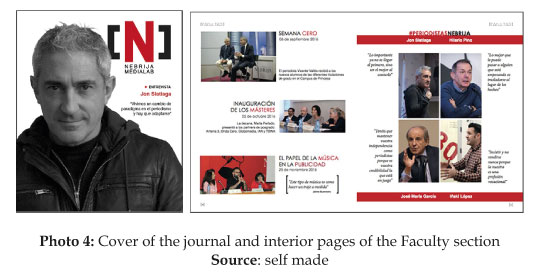
The Advertising Laboratory coordinated by Professor Leticia Rodríguez has contributed to the journal by providing the advertising pages included in the publication. From their laboratory, students were offered a briefing on the commercial objectives that were intended. The advertising pieces that were commissioned have been about the monthly meetings with journalists (Nebrija Journalists) and advertising (Brand Lovers) of recognized prestige; and a last one, on the MediaLab platform itself, as a learning space. The back cover announcement has been facilitated by the Marketing Department of the institution and it is an advertising piece, where the educational offer of undergraduate and postgraduate courses for the next 2017-2018 academic year is presented.
In order to achieve the objectives set in the project of the journal, students have had to put to the test a series of non-negligible skills and abilities, such as writing texts on current news topics, using the camera correctly, knowing advertising techniques to advertise any product or service and easily handling design applications such as Indesign, Illustrator and Photoshop. The header of the journal has been created in Illustrator, the images have been treated in Photoshop and the application in which all the pages of the journal have been mounted has been Indesign. Experimenting with the header has allowed them to learn which graphic elements have visual strength and which do not. In the same way, they have learned to be selective with the graphic material delivered, reviewing the quality of the images that go to the printing press. Adjusting the texts, photos, graphics and headlines on the pages has provided them with skills to sort, value and prioritize the information and nothing better than doing it with real texts from other colleagues, with which we must be very respectful.
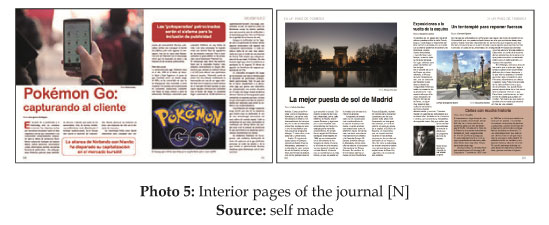
The students have put to the test the competences of subjects such as journalistic writing, photojournalism, photography: composition and aesthetics, graphic design, journalistic design and advertising design to be able to create and develop this multidisciplinary project. All these subjects are located in the first two courses of our degrees.
The coordinating professors of each of the Laboratories act as coaches for the enrolled students. In our laboratories, they put into practice essential skills and abilities for their professional development.
The journal [N] has published its first issue in mid-February 2017 and it has been a very enriching educational experience for all. Many thanks to all the students participating in this professional project without whom it would have been impossible to live this stimulating experience.
5. CONCLUSIONS
– The university journal [N] is a clear learning result. It has been a great impulse for the students that the publication is published on paper and with a modest print run of 300 copies. The next step will be to upload it to the University website to increase its visibility.
– Working for several months aiming at a multidisciplinary and integrating project has been a real challenge.
– The synergies created between the three laboratories involved; current events, design and advertising, has been excellent. Each student assumes a professional role, writes texts, takes photos, makes the journal or creates advertising pages. The students have experienced that teamwork is the only formula to achieve the success of the proposed project.
REFERENCES
1. Bain K (2010). Lo que hacen los mejores profesores. Valencia: PUV.
2. González JA (2016). Los labs de medios en España: la innovación desde el área de la organización periodística. Cuadernos de Periodistas 33:49-63.
3. Martí J, Heydrich M, Rojas M, Hernández A (2010). Aprendizaje basado en proyectos. Revista Universidad EAFIT 46(158):11-21.
4. Perlado M, Saavedra M (2016). Nebrija Medialab, espacio experiencial de aprendizaje y desarrollo profesional para los estudiantes del área de comunicación. En Membiela P, Casado N, Cebreiros I (eds), La docencia universitaria: desafíos y perspectivas. Vigo: Educación Editora.
5. Salaverría R (2015). Innovar en prensa: dónde, cómo y por qué. En Libro blanco de la prensa diaria. Madrid: Asociación de Editores de Diarios Españoles. 149-154.
6. Salaverría R, Sábada C (2016). Los labs de medios en España: modelos y tendencias. En Casero-Ripolles A (ed), Periodismo y democracia en el entorno digital. Madrid: Sociedad Española de Periodística. 149-164.